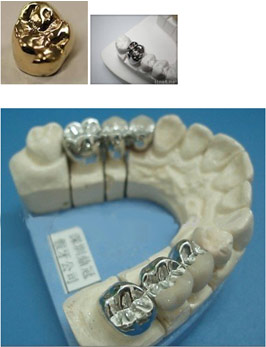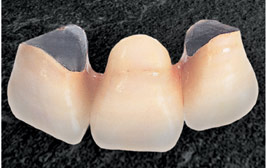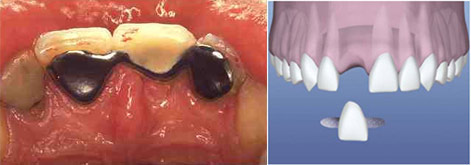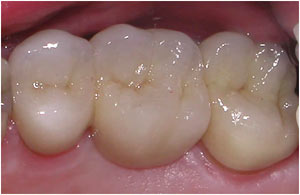When teeth are heavily decayed they may be too weak to survive with just a filling. By placing a crown, a tooth may be given a new lease of life. Even when a single tooth is lost a denture may not be required as a bridge can be made which spans the gap with a tooth attached to those next to the space. Sometimes when a single small tooth is lost at the front of the mouth a simple bridge can be made which has 'wings' that are glued to the back of the adjacent teeth. This results in less tooth being damaged by the drill.
Crowns
When a tooth is heavily decayed it is more likely to fracture and lose considerable tooth substance. The greater risk is that a fracture line may go below the margin of the gum which makes restoration more difficult or near impossible.
Crowns may be made from several different materials, steel, gold and porcelain being the most common types.
Gold is usually used on the back teeth, as it has several advantages over porcelain teeth
- Gold is strong in thin section and less tooth needs to be drilled away before taking the impression and fitting the crown.
- The lab technician finds it easier to use gold as it shrinks less when cast and is easier to polish. Crowns of porcelain shrink when cast and the technician has to estimate this when making the crown.
Porcelain is usually always used for the front teeth but may be used for the back teeth. This material can be made to appear very natural though several factors affect this and are outlined below;
Some porcelain crowns have metal inside which gives strength and support to the porcelain. This acts as a barrier for light and gives the crown a dull color. On posterior teeth this won't be noticed but in the front of the mouth it can occasionally be a problem as the tooth looks duller than the natural teeth.
Post Crown
When the top of a tooth is lost due to decay there may be very little for the crown to actually hold onto. To gain 'retention' as dentists call it, a post is placed inside the tooth which forms a peg on top of the tooth and acts as a seat for the crown. Post crowns have a shorter lifespan than normal crowns as the roots may be brittle and weaker. Usually a post crown is a better option than having the tooth extracted with a subsequent denture or bridge.
Bridges
A bridge allows the dentist to replace lost teeth without the use of a denture or dental implant. Basically a false tooth is held in place by being attached to a tooth next door. The disadvantage is that the teeth next to the space have to be prepared in a similar way to a crown in order to accept the bridge. If these teeth already have crowns or big restorations then this is not a problem, the major concern however is when these teeth have small or no restorations (fillings). One compromise is the 'acid etched bridge', with this type a fine ledge is placed on the back of the adjacent teeth
One disadvantage of a bridge is that the patient should wait three months before placement as the 'gum' shrinks' after a tooth is extracted. If the bridge was fitted early a gap would appear underneath the pontic (the false tooth). At the back of the mouth this may not be a problem, at the front of the mouth however this may appear as a black line along the gum.
Maryland Bridge
Normally a bridge requires the adjacent teeth to be prepared to accept the abutments of the bridge. This is destructive to these teeth especially if they have small or no fillings in them. A more conservative approach is a 'Maryland bridge' which uses wings that attach to the adjacent teeth. The disadvantage of these systems is that the life expectancy of the bridge is only 4-5 years when compared to the conventional type of 8 years.
All Ceramic Crowns and Bridges (Metal Free ceramic crowns)
These are the best looking crowns, and probably the best values for your money as far as esthetics are concerned. Contrary to what might appear, these materials are extremely strong and fracture tough. The material can well sustain the masticatory forces, providing durable crowns and bridges with beautiful esthetic results. They can be conveniently and reliably used in any part of the mouth. These are also the preferred material of choice in patients with metal allergies.
Improved Aesthetics 
1) Due to the white zirconium oxide milled substructure
2) Optimal shade match to the existing natural teeth
Compatibility
1) Verified by the medical application of zirconium oxide for about 20 years
2) No allergic reactions reported in the published literature
3) Good insulating behavior of the ceramic against cold/warm influences
4) Thanks to a smooth ceramic surface that supports good oral hygiene
5) No interaction with other dental materials

